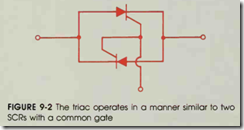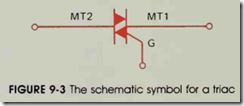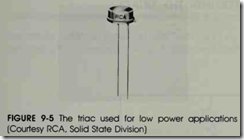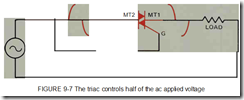Objectives
After studying this unit, the student will be able to:
• Draw the schematic symbol for a triac
• Discuss the similarities and differences between SCRs and triacs
• Discuss the operation of a triac in an ac circuit
• Discuss phase shifting a triac
• Connect a triac in a circuit
• Test a triac with an ohmmeter
The triac is a PNPN junction connected par allel to an NPNP junction. Figure 9-1 illustrates the semiconductor arrangement of a triac. The triac operates in a manner similar to that of two connected SCRs, figure 9-2. The schematic sym bol for the triac is shown in figure 9-3.
When an SCR is connected in an ac circuit, the output voltage is direct current. When a triac is connected in an ac circuit, the output voltage is alternating current. Since the triac operates like two SCRs that are connected and facing in oppo site directions, it will conduct both the positive and negative half cycles of ac current.
When a triac is connected in an ac circuit as shown in figure 9-4, the gate must be connected to the same polarity as MT2. When the ac voltage applied to MT2 is positive, the SCR, which is for ward biased, will conduct. When the voltage ap plied to MT2 is negative, the other SCR is for ward biased and will conduct that half of the waveform. Since one of the SCRs is forward biased for each half cycle, the triac will conduct ac current as long as the gate lead is connected to MT2.
The triac, like the SCR, requires a certain amount of gate current to turn it on. Once the triac has been triggered by the gate, it will con tinue to conduct until the current flowing through MT2-MT1 drops below the holding current level.
THE TRIAC USED AS AN AC SWITCH
The triac is a member of the thyristor family, which means that it has only two states of opera tion, on and off. When the triac is turned off, it drops the full applied voltage of the circuit at 0 amps of current flow. When the triac is turned on, it has a voltage drop of about 1 volt and circuit current must be limited by the load connected to the circuit.
The triac has become very popular in indus trial circuits as an ac switch. Since it is a thyristor, it has the ability to control a large amount of volt age and current. There are no contacts to wear out, it is sealed against dirt and moisture, and it can operate thousands of times per second. The triac is used as the output device of many solid state relays which will be covered later. Two types of triacs are shown in figures 9-5 and 9-6.
THE TRIAC USED FOR AC VOLTAGE CONTROL
The triac can be used to control ac voltage, figure 9-7. If a variable resistor is connected in series with the gate, the point at which the gate cur rent is high enough to fire the triac can be ad justed. The resistance can be adjusted to permit the triac to fire when the ac waveform reaches its peak value. This will cause half of the ac voltage to be dropped across the triac and half to be dropped across the load.
If the gate resistance is reduced, the amount of gate current needed to fire the triac will be ob tained before the ac waveform reaches its peak value. This means that less voltage will be dropped across the triac and more voltage will be dropped across the load. This circuit permits the triac to control only one half of the ac waveform applied to it. If a lamp is used as the load, it can be controlled from half brightness to full bright ness. If an attempt is made to adjust the lamp to operate at less than half brightness, it will turn off.
PHASE SHIFTING THE TRIAC
To obtain complete voltage control, the triac, like the SCR, must be phase shifted.· Several methods can be used to phase shift a triac, but only one will be covered in this unit. In figure 9-8, a diac is used to phase shift the triac. Resis tors R1 and R2 are connected in series with capac itor Cl. Resistor R1 is a variable resistor which is used to control the charge time of capacitor Cl.
Resistor R2 is used to limit current if resistor R1 is adjusted to 0 ohms. Assume that the diac con nected in series with the gate of the triac will turn on when capacitor C1 has been charged to 15 volts. When the diac turns on, capacitor C1 will discharge through the gate of the triac. This per mits the triac to fire, or turn on. Since the diac is a bidirectional device, it will permit a positive or negative pulse to trigger the gate of the triac.
When the triac fires, there is a voltage drop of about 1 volt across MT2 and MTl. The triac remains on until the ac voltage drops to a low enough value to permit the triac to turn off. Since the phase shift circuit is connected parallel to the triac, once the triac turns on, capacitor C1 cannot begin charging again until the triac turns off at the end of the ac cycle.
Notice that the pulse applied to the gate is controlled by the charging of capacitor C1, not the amplitude of voltage. If the correct values are cho sen, the triac can be fired at any point in the ac cycle applied to it. The triac can now control the ac voltage from 0 to the full voltage of the circuit. A common example of this type of triac circuit is the light dimmer control used in many homes.
TESTING THE TRIAC
The triac can be tested with an ohmmeter (see Procedure 5 in the Appendix). To test the triac, connect the ohmmeter leads to MT2 and MTI. The ohmmeter should indicate no continu ity. If the gate lead is touched to MT2, the triac should turn on and the ohmmeter should indicate continuity through the triac. When the gate lead is released from MT2, the triac may continue to conduct or it may turn off depending on whether the ohmmeter supplies enough current to keep the device above its holding current level. This tests one half of the triac.
To test the other half of the triac, reverse the connection of the ohmmeter leads. The ohmmeter should indicate no continuity. If the gate is touched again to MT2, the ohmmeter should in dicate continuity through the device. The other half of the triac has been tested.
REVIEW QUESTIONS
1. Draw the schematic symbol for a triac.
2. When a triac is connected in an ac circuit, is the output ac or de?
3. The triac is a member of what family of devices?
4. Briefly explain why a triac must be phase shifted.
5. What electronic component is frequently used to phase shift the triac?
6. When the triac is being tested with an ohmmeter, which other terminal should the gate be connected to if the ohmmeter is to indicate continuity?






